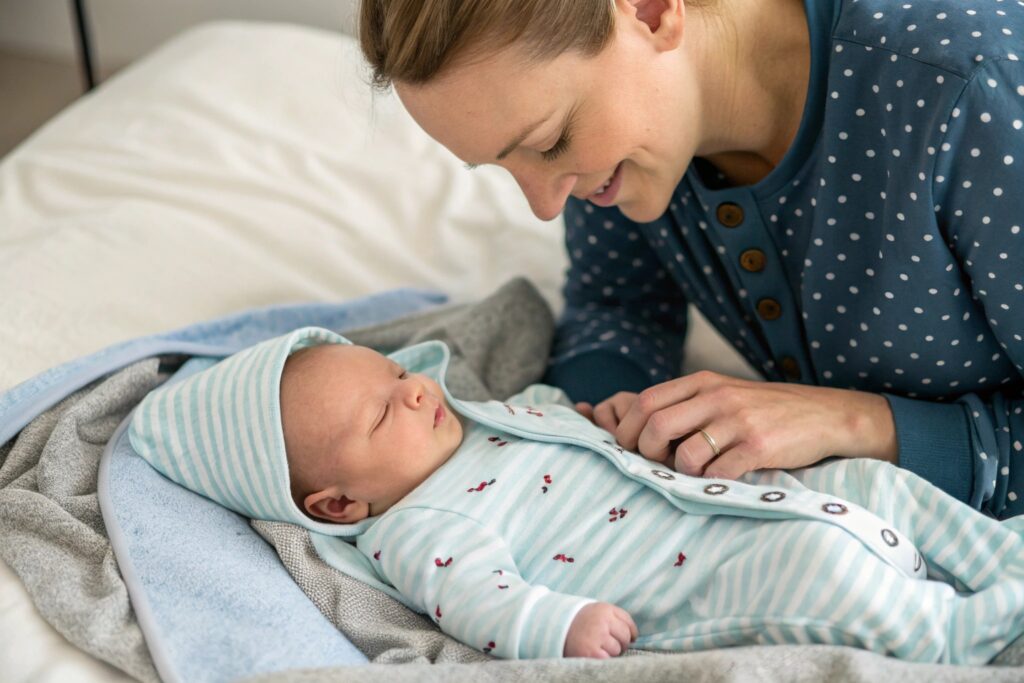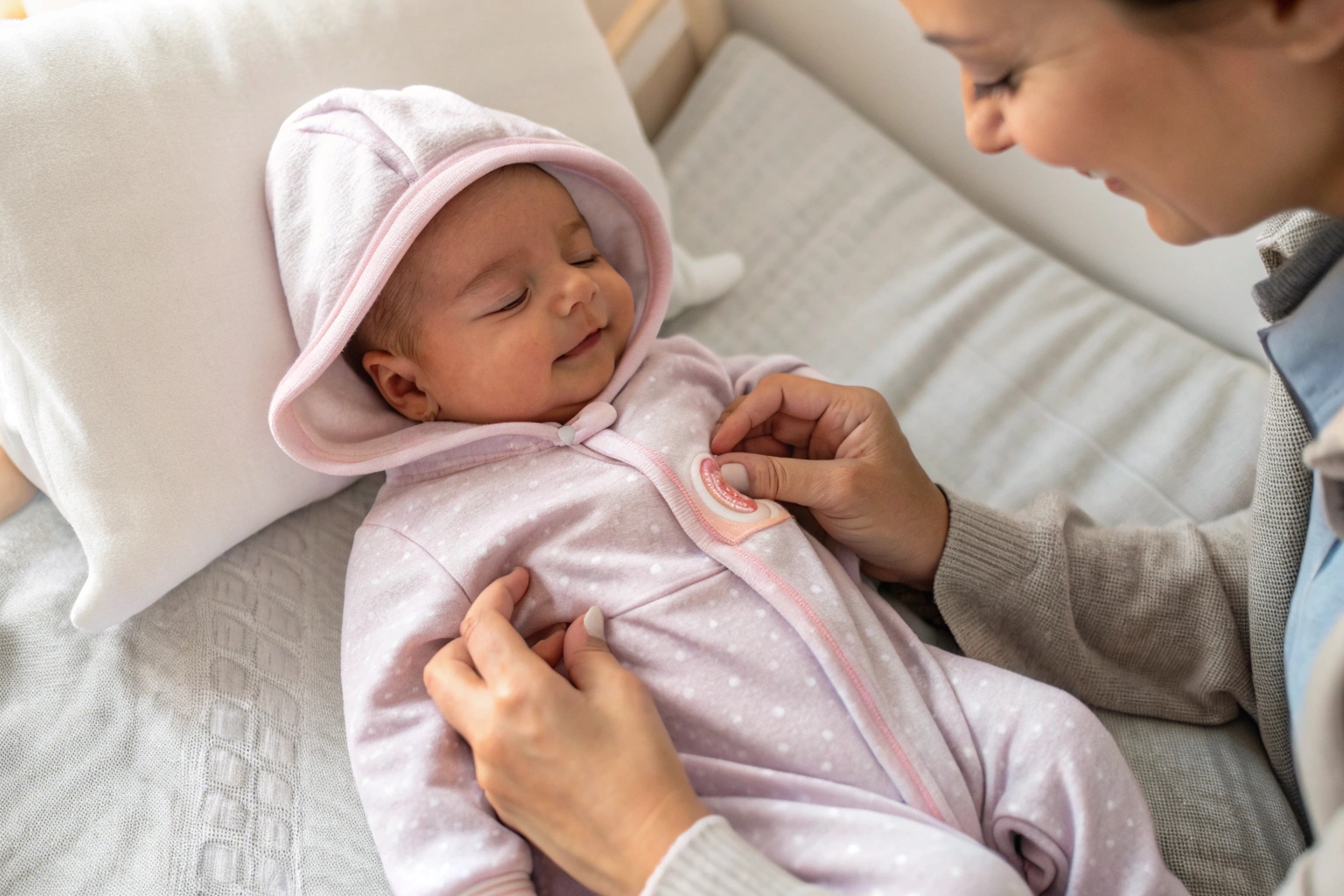For new parents, babywear isn’t just another purchase—it’s a layer of protection, comfort, and love. They want clothing that feels soft, proves safe, and fits just right, every single time.
Parents want babywear that is soft to the touch, safe on sensitive skin, and properly fitted to growing babies—without sacrificing convenience or style.
Here’s what truly matters to parents when they shop for baby clothing—and how brands can deliver on every expectation.
Why Fabric Softness Matters in Newborn Clothing?
Newborn skin is delicate—more sensitive than any adult’s. That’s why parents instinctively reach for fabrics that feel gentle and breathable.
Fabric softness matters because newborn skin is fragile, easily irritated, and vulnerable to rough textures, dyes, and synthetic blends.

What defines “soft” for a parent?
It’s not just a marketing word. Softness, for new parents, means:
- No rough seams or tags
- No stiffness or “crunchy” feel after washing
- Smooth against necks, wrists, thighs, and tummies
- Soft enough to wear without an undershirt
They often test by rubbing fabric against their cheek or wrist—mimicking how it will feel on baby’s skin.
| Fabric Type | Softness Level | Common Use in Babywear |
|---|---|---|
| Organic cotton (combed) | ⭐⭐⭐⭐⭐ | Bodysuits, rompers, sets |
| Bamboo rayon blend | ⭐⭐⭐⭐ | Sleepwear, footies |
| Modal or TENCEL™ | ⭐⭐⭐⭐ | Luxe newborn essentials |
| Rough polyester blends | ⭐ | Often rejected by parents |
How should brands respond?
- Use soft-touch certified fabrics (GOTS, OEKO-TEX)
- Pre-wash or pre-shrink to prevent stiffness
- Avoid tags—use printed or heat-sealed labels
- Show texture in product photos (close-ups help)
When babywear feels soft, it becomes the go-to piece every time.
How to Ensure Baby Clothes Are Truly Safe?
Safety isn’t optional—it’s expected. Parents won’t tolerate clothes that cause rashes, contain harmful substances, or include risky designs.
To ensure safety, baby clothes must use non-toxic materials, follow international safety standards, and eliminate choking or skin irritation risks.

What do parents worry about most?
- Chemical dyes and textile residues
- Nickel or rough metal snaps
- Small detachable parts or loose threads
- Labels that irritate or rub
- Clothes that shrink or warp dangerously after washing
They also worry about overheating or poor breathability—especially for babies born in warm seasons.
What proves safety to parents?
| Safety Feature | How It Helps Parents Feel Confident |
|---|---|
| OEKO-TEX / GOTS Label | Verifies chemical-free, skin-safe fabric |
| EN71 / ASTM standards | Shows child-safety testing for parts |
| Seam inspection | Avoids threads that wrap around fingers |
| Safe closures | Plastic snaps over metal zippers |
| Flame resistance (where needed) | Follows sleepwear laws |
Add clear product copy like:
“Made from OEKO-TEX certified organic cotton—safe for newborn skin and tested for over 100 harmful substances.”
Safety is peace of mind. Don’t assume—prove it.
What Makes a Perfect Fit for Growing Babies?
Babies grow fast. Clothes that fit one week might feel tight the next. The perfect fit must adapt, flex, and give room without feeling sloppy.
A perfect fit in babywear means freedom of movement, space for diapers, safe seams, and smart sizing that works for fast-changing bodies.

What do parents mean by “fit”?
It’s not about tightness—it’s about:
- Not riding up when crawling
- Enough leg and diaper room
- Stretch in arms and cuffs
- Length that grows with the baby (just a little)
And yes, some want snug fits for layering in winter, others want relaxed fits in warmer weather. That’s why flexibility matters.
How can brands deliver better fit?
| Fit Factor | What to Offer |
|---|---|
| Stretchy necklines | Envelope neck or snap shoulders |
| Diaper-friendly bottoms | Roomy hip area and snap access |
| Foldable cuffs | Grows with baby, especially in rompers |
| True sizing charts | Based on weight and height, not just age |
Include fit notes in product pages:
“This style runs true to size, with a bit of extra length for growth.”
Also show baby model stats:
“Model is 6 months, 68 cm, 8.2 kg—wearing size 73 (6–9M)”
Parents want to avoid guessing. Give them proof.
How Brands Can Meet Parents’ Babywear Expectations?
It’s not just about what you sell—it’s about how you show up for parents. Brands that deliver clarity, care, and consistency win trust fast.
To meet expectations, babywear brands must combine quality product design with honest information, fast support, and family-friendly shopping experiences.

What do parents expect from baby clothing brands?
| Expectation | What It Looks Like in Practice |
|---|---|
| Softness | Fabric tags, reviews, texture video |
| Safety | Certifications and testing labels |
| Fit clarity | Real baby photos, clear size chart |
| Easy returns | Flexible policies for fast-growing babies |
| Warm tone communication | Kind replies, family-first voice |
Make their journey easier:
- Show outfit photos in everyday use
- Add “wear and care” tips in packaging
- Offer “build-a-bundle” tools with size mixing
- Provide live chat sizing support
Above all, listen. Gather feedback and evolve.
Conclusion
What parents really want isn’t a mystery—they want babywear that’s soft, safe, and fits like it was made for their child. Brands that deliver on these three points—while adding care, clarity, and comfort—earn trust, love, and lifelong loyalty.










